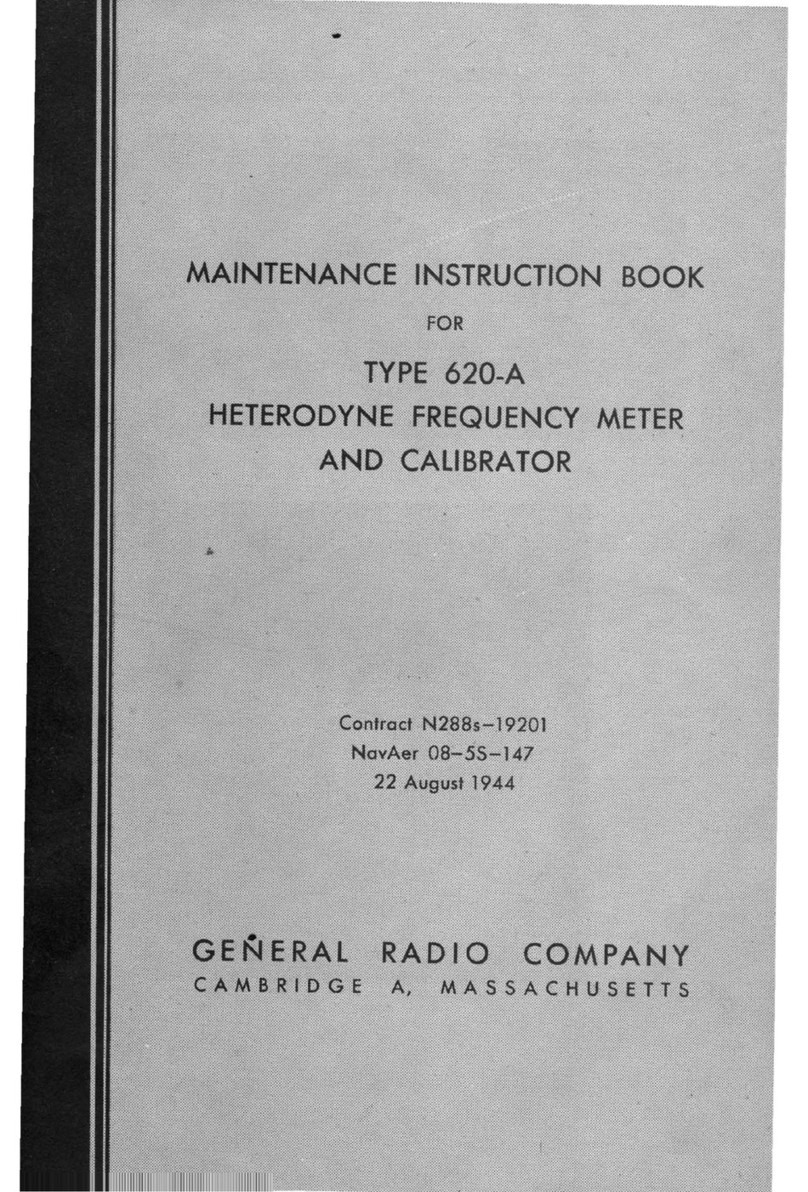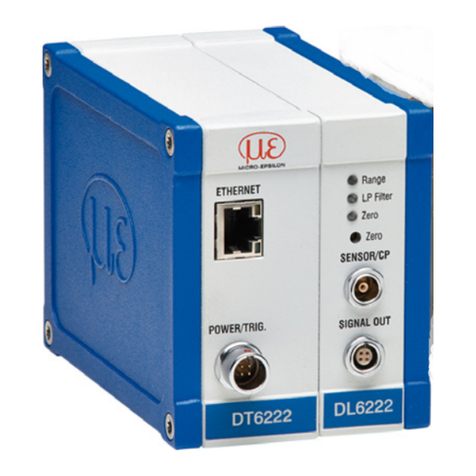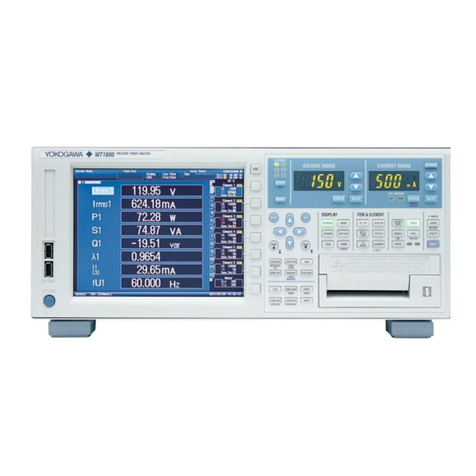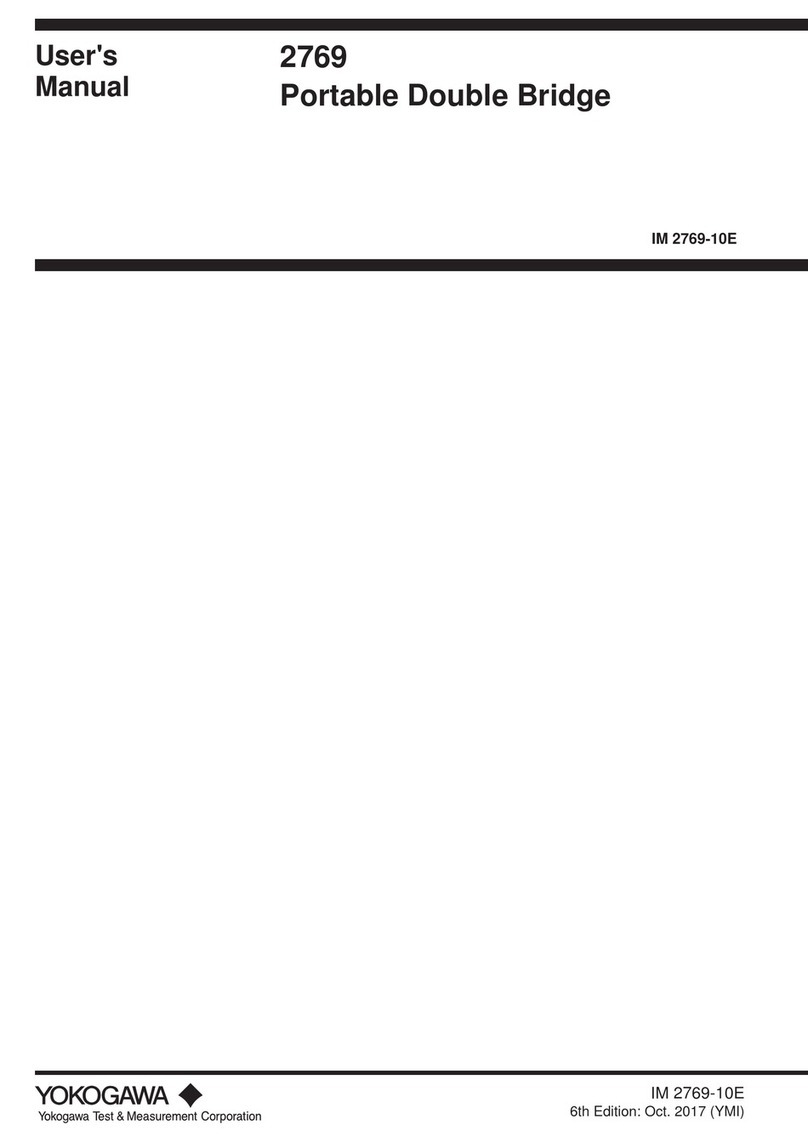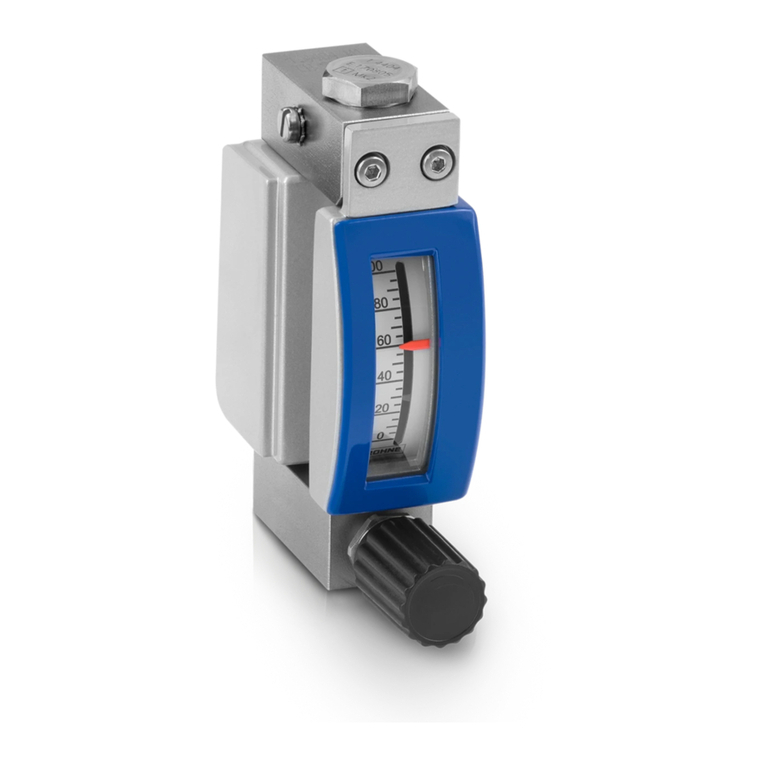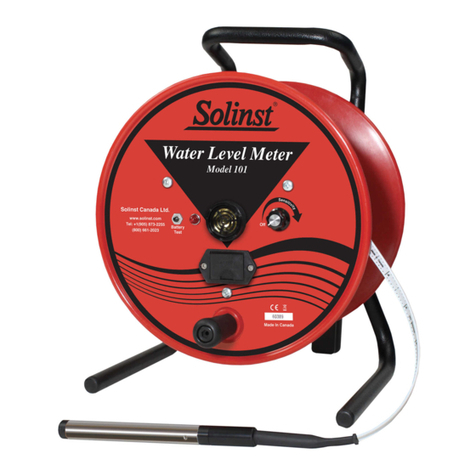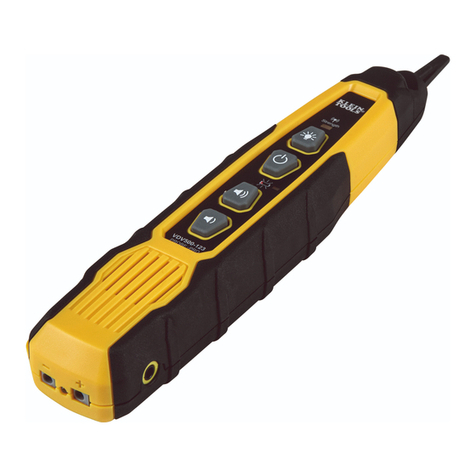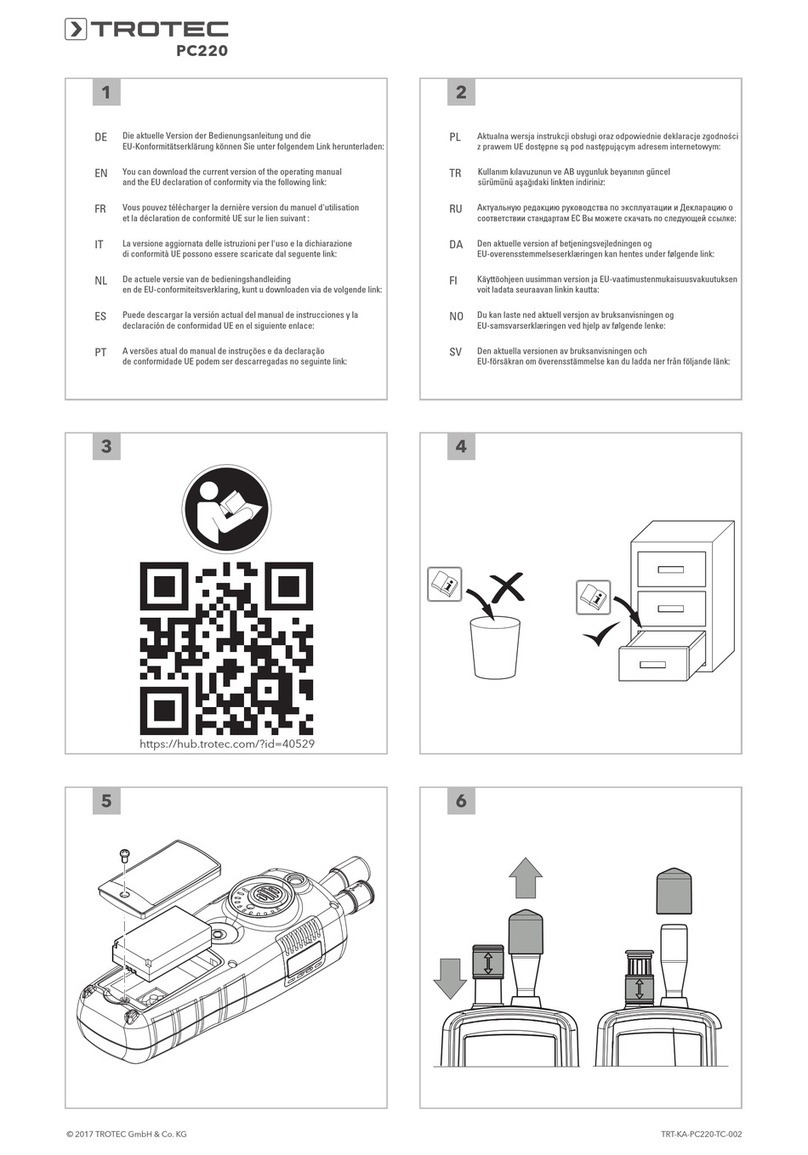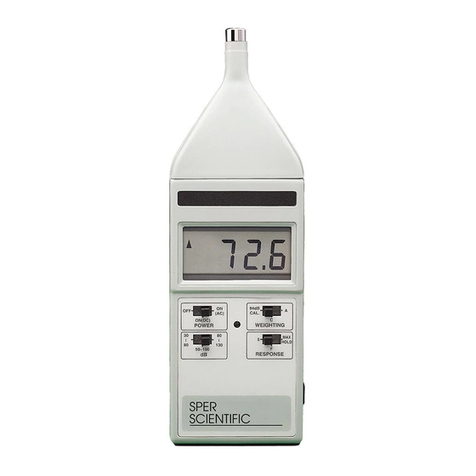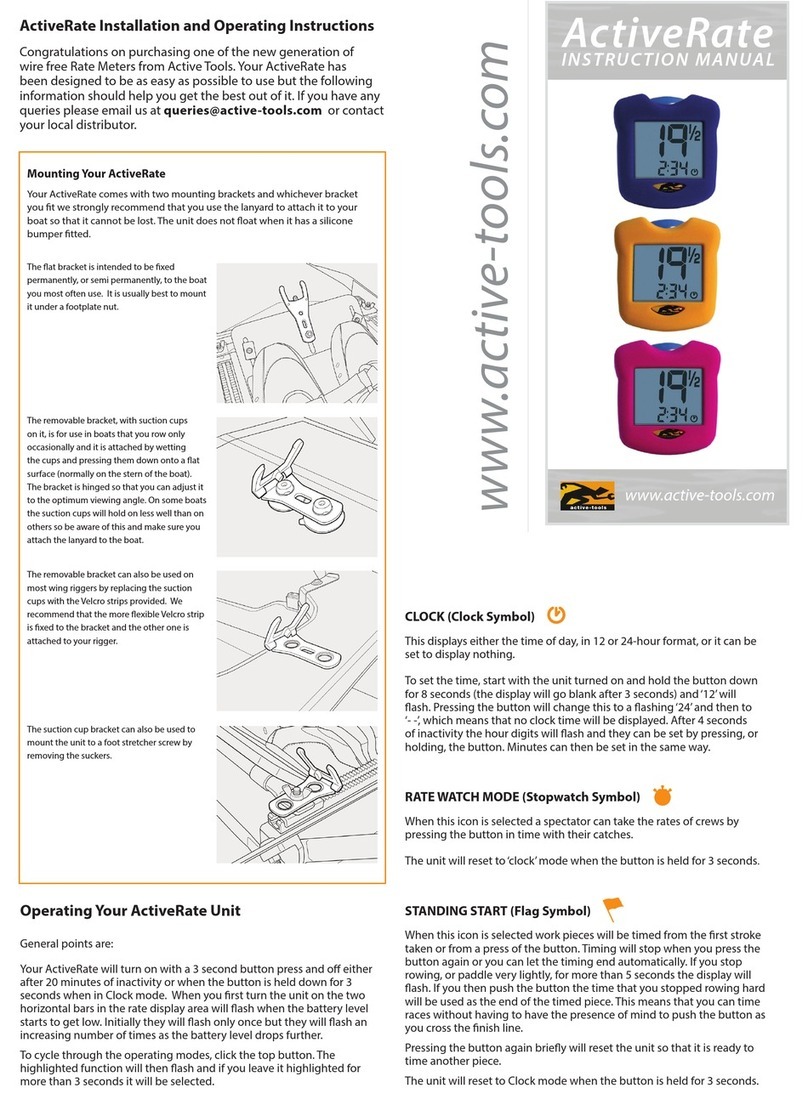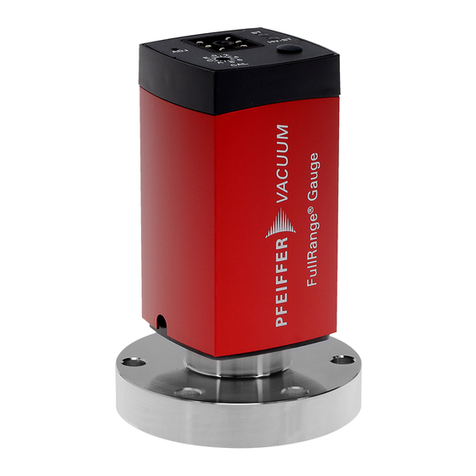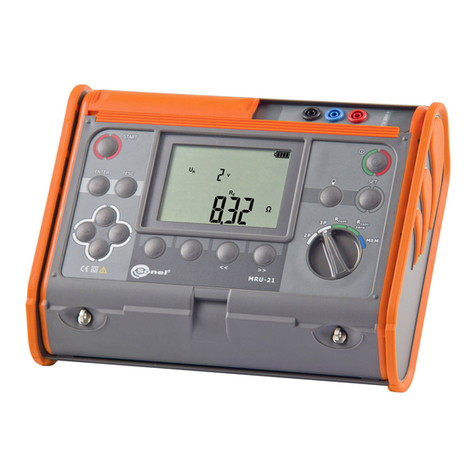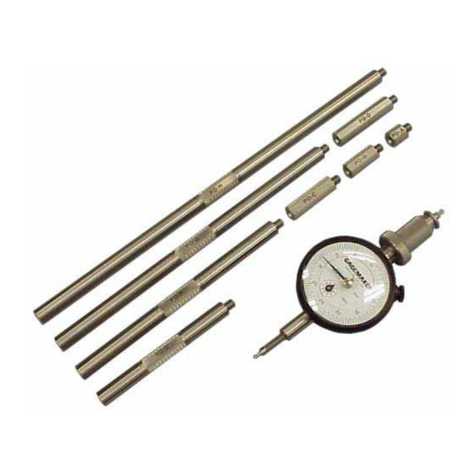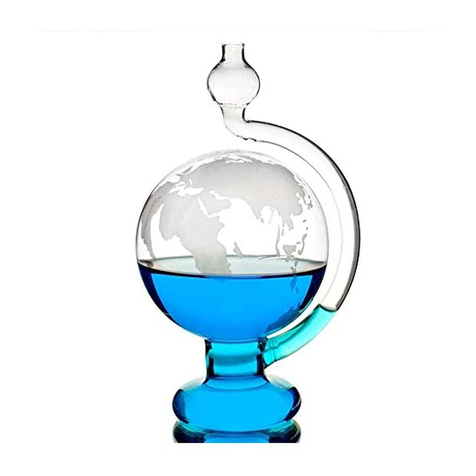GENERAL RADIO COMPANY 732-B User manual

www.SteamPoweredRadio.Com
~
"'
. '
('
~
RAD
IO
SJ.TJO
N
KCBS
140
Je
,·
3
St
r
eet
San
Fr
an
c
is
co
5,
Calif
._
,,I'_
~
FOR
TYPE
732
DI
STORTION
AND
NOISE
METER
'11/i.
TYPE
733
-A
OSCILLATOR
AND
TYPE
732
-
PI
RANGE
EXTENSION
.!j_. .. F
ILTERS
t
FOR
M
518-
C
.' <
.Jt
· . :'9
l
"
GENERAL
RADIO
COMPANY
C.AM,BRf DG£
A,
MA -S sA CH u$ ET l' sX
.,,
:
,
'-....

www.SteamPoweredRadio.Com
TABLE
OF
CONTENTS
TYPE
732-B
DISTORTION
AND
NOISE
METER
Description
Schematic
Diagram
Installation
..•
Operation
Suggestions
for
Use
Servicing
Vacuum-Tube
Data
Parts
List
..
.
Circuit
Diagram
TYPE
733-A
OSCILLATOR
Description
Installation
and
Operation
Circuit
Diagram
TYPE
732-Pl
RANGE
EXTENSION
FILTERS
Description
Block
Diagram
Installation
.
Operation
Suggestions
for
Use
PHOTOGRAPHS
.. .. ..
.
PATENT
NOTICE
l
1
1
2
4
5
6
6
7
8
9
11
11
11
12
12
12
13
These
instruments
are
manufactured
and
sold
under
patents
of
the
American
Telephone
arld
Telegraph
Company
solely
for
util
i
zation
in
re-
search,
investigation,
measurement,
testing
,
instruction
and
develop-
ment
vork
1n
pure
and
applied
science.

www.SteamPoweredRadio.Com
1.1
FUNCTION
OPERATI
NG
INSTRUCTIONS
FOR
TYPE
732
-B
DISTORTION
AND
NOISE METER
1.0
DESCRIPTION
The
Type
732-B
Distortion
and
Noise
Meter
is
int
ended
for
use
in
radi
o
stations
to
measure
the
audio-frequency
distortion
and
no
i
se
level
in
the
transmitter
outp
ut
as
well
as
1n
the
audio-frequency
por-
tion
of
the
tran
s
mitter
equipment.
It
can
also
be
used
in
distortion
mea
surements
on
other
types
of
audio
-
frequency
equipment
and
ir.
the
production
testing
of
radio
receivers
.
1 .2
RANGE
AND
ACCURACY
1.21
Distortion
Range:
D
ist
ortion
~ s
read
directly
from
a
large
meter.
Full-scale
values
of
3
~,
1~
,
3%
,
and
1~
are
provided,
andare
selected
by
a
multiplier
switch.
The
range
for
carrier
noise
measure
-
ment
is
from
30
to
70
db
below
100~
modulation
or
65 db
below
an
aud
io
-
fr
eq
uency
signal
of
zero
level
.
1 .22
Audio
-
Frequency
Range:
380-420
cycles
for
distortion
meas-
urements;
30-24
,000
cycles
for
noise
or
hum
measurements.
For
extend-
ing
the
distortion
measurements
range,
use
Type
732-Pl
Range
Extension
Filters
with
the
Type
732-B
Distortion
and
No
i
se
Meter.
1 .
23
Carrier
Frequency
Range: The Type
732-B
Dist
o
rtion
and
Noise
Meter
is
designed
to
operate
at
any
carrier
frequency
betwe
en
0 .5
and
60 megacycl
es
.
This
range
is
co
vered
by
two
coil
s . A s
ingle
c6il
DIODE
EN
VELOPE
·P
[t
9
~~~~I
I
I:
.400~
HIGH
PASS
fl
lT
ER
Pl:RCE
NTAGE
DISTORTIO
N
~URE
1.
Schematic
circuit
diagram
of
Type
732
-B
Distortion
and
Noise
Meter
-1-

www.SteamPoweredRadio.Com
GENERAL
RADIO
COMPANY
(either
for
the
o.5-8
Mc
range
with
the
instrUDtent
unless
both
coils
a
re
readily
interchanged.
or
for
the
3-60
Mc
range)
is
supp
lied
coils
are
specifically
ordered.
The
1.24
Accuracy:
The
over-all
accuracy
of
measurement
of
each
dii>-
tortion
range
is
better
than
±5%
of
full
scale
:!:0.1%
distortion.
1.3
PRINCIPLE
OF
OPERATION
1.31
Schematic
Circuit
Diagram:
The
operation
of
the
Type
732-B
Distortion
and
Noise
Meter
is
shown
by
Figure
1.
1.32
Radio-Frequency
Circuit:
A
400-cycle
modulated
radi
o
-fre-
quency
voltage,
applied
to
the
input
terminals,
1s
coupled
to
a
tuned
circuit
and
to
a
diode
rectifier.
The
carrier
level
1s
indicated
on
a
d-c
meter
that
can
be
switched
in
series
with
the
diode
rectifier.
The
positive
half
of
the
modulated
radio-frequency
wave
is
demodulated
by
the
diode
and
passed
through
a
filter
which
rem
oves
the
radio-frequency
components.
1.33
Audio-Frequency
Circuit:
The
filter
output
voltage
consists
of
an
a-c
component
(corresponding
to
the
varying
envelope
of
the
o
rigi-
nal
modulated
signal)
superposed
on
a
d-c
component
produced
by
recti-
fication
of
the
carrier.
~
For
measurements
of
harmonic
distortion,
the
output
of
thi
s
filter
~
is
passed
through
a
400-cycle
high-pass
filter,
removing
the
400
-
cycle
fundamental
of
the
audio
frequency
but
leaving
all
its
harmonics.
The
amplitude
of
the
harmonic
voltage
is
then
indicated
by
the
attenuator
and
the
output
meter.
The
attenuator
dial
is
provided
with
a
calibra-
ting
position
vhich
is
used
to
standardize
the
meter
sca
le
in
terms
of
the
original
400-cycle
amplitude,
before
making
the
measurement.
This
setting
is
made
by
adjusting
the
amplifier
gain
for
a
full-scale
deflec-
tion
on
the
meter,
when a
fraction
of
the
envelope
amplitude
is
applied
to
the
amplifier.
~
For
noise
and
hum
measurements
the
output
of
the
radio-fre-
quency
filter
is
applied
directly
to
an
attenuator.
The
calibration
adjustment
is
made
with
the
transmitter
modulated
at
the
level
with
which
it
ls
desired
to
compare
noise.
With
the
modulating
voltage
re-
moved
from
the
transmitter,
the
noise
level
in
decibels
below
the
modu-
lated
signal
level
is
indicated
on
the
meter.
2.0
INSTALLATION
2
.1
VACUUM
TUBES
All
tubes
are
supplied
with
the
instrument.
ets
indicate
tube
locations.
2
.2
INPUT
COUPLING
COILS
Markers
on
the
sock-
2.21
Two
coils
are
available
to
cover
tbe
carrier
frequency
range.
The
Type
732
-
PS
Coil
covers
the
0.5
to
8
Mc
portion
of
the
range.
The
Type
73
2
-P6
Coil
covers
the
3
to
60
Mc
portion
or
the
range.
Each
coil
covers
its
portion
of
the
range
in
four
steps
as
~elec-
ted
by
tbe
o
rientation
of
the
coil
in
tts
receptacle.
2.22
The
coil
provided
with
the
distortion
and
noise
meter
can
ea~ily
be
removed
and
replaced
vith
the
coil
for
the
other
frequency
range
. _
A.
,
The
coil
is
plugged
into
the
receptacle
provided
fo
r
this
purro~
~
at
the
rear
of
the
instrument.
It
must
be
so
oriented
that
the
desired
-2-

www.SteamPoweredRadio.Com
GENERAL RADIO
COMPANY
po
rt
io
n
of
ite
f
reque
n
cy
rang
e i e
th
e
po
r t i
on
indi
cat
ed
on
the
coil
plate
1n
t he ho
riz
on
tal
po
si
t
io
n. A cowl
fa
s
tene
r
hold
s
the
coil
se-
cur
ely
1n
p
lace
. The
ra
di o
-fr
e
que
n
cy
j
ac
k-t
op
terminal
s
are
on
the
coil
mount
ing
. Be
sure
t o g
round
t he
uninsulated
terminal.
This
gr
oun
ds
pan
el
8.Il
d
fr
ame
as
well.
2.23
The
Type
732
-P5
Coupling
Coil
(0.5
to
8
Mc)
is
wound With 18
tu
r
ns'"cirwire
on
the
input
side
with
taps
at
6
turns
and
at
2
turns.
The
coil
is
supplied
with
th
e
insulated
terminal
connected
t o
the
full
w
inding
(18
turns)
since
t
his
is
the
optimum
connection
for
use
at
broadcast
frequencies
.
If
the
coil
is
to
be
used
at
higher
frequencies,
the
insulated
terminal
must
be
disconnected
from
the
18-turn
terminal
and
connected
to
a
tap
of
lowe
r
turns:
6
turns
up
to
4
Mc
and
2
turns
for
the
4
to
8
Mc
portion
of
the
range,
for
example.
2,3
MOUNTING
When
used
with
the
other
instruments
in
a
Class
730
Transmission
Monitoring
Assembly,
install
panel
s
in
the
fol
l o
wing
orde
r:
Type 733
Oscillator
or
Type
608
-A
Oscillator
at
tne
top
, Type 731-B M
odula
tion
Monitor
in
the
middle
and
Type
732-B
Dis
torti
on
and
Noise
Meter
at
the
bottom
. When
the
Type
732-Pl
Range
Extention
Filter
s
are
used,
they
must
be
placed
d-1.rectly
below
the
Type 732-B
Distortion
and
Noise
Meter.
2,4
CAUTION
The
two
connectors
furnished
with
Noise
Meter
must
be
inserted
at
the
rear
Type
732
-
Pl
Range
Extensi
on
Filters
are
Distortion
and
Noise
Meter.
2,5
POWER
SUPPLY
the
Type
732-B
Distortion
and
of
the
instrument
unless
the
used
in
conjuncti
on
with
the
Connect
the
instrument
to
the
power
line
by
means
of
the
cord-and-
plug
assembly
supplied
. The power
line
frequency
can
be
from
40
to
60
cycles
. The power
line
voltage
must
be
a s
ind
i
cated
on
the
name
plate
near
the
power
receptacle
at
the
rear
of
the
instrument
(11
5 or
230
v
olts).
The
connections
on
the
power
tran~former
in
the
instrument
can
ea
s
ily
be
changed
for
operat
i
on
from
either
a
115-volt
or
a
230-volt
l i
ne.
For
ope
ration
at
115
volt
s ,
connect
#1
to
#3
and
#2
to
#4.
For
operation
at
230
volts,
connect
#2
to
#3
.
The
numbers
refer
to
the
ter-
minals
on
the
power
transi'ormer
.
When
a
change
1n
transformer
connec
-
tions
i s made,
the
name
plate
must
likewise
be
changed.
The
plate
i s
stamped
on
one
side
for
115
volts,
40-60
cycles
and
on
the
other
side
for
230
volts,
40-60
cycles.
If
any
di
fficulty
with
a-c
hum
is
encountered,
r
eve
rse
the
line
plug
,
2.6
COUPLING
TO
TRANSMITTER
2.61
The
most
convenient
way
to
co
u
ple
the
Type
732-B
D1stort1o~
a
nd
Noise
Meter
to
the
transmitter
is
to
install
a
small
coll
of
a
very
few
turns
close
to
the
antenna
lead
or
to
the
tank
circuit
. Thi s
coil
is
then
connected
to
the
carrier
input
terminals.
An
ordinary
rubber-
insulated
single
-
conductor
concentric
cable
of
around
75
ohms
impedance
has
been
found
conven
i
ent.
This
forms
a
low-impedance
link
circuit
with
the
coil
mounted
in
the
instrument.
• ment
-
--
2.62
Sufficient
coupling
must
.
be
provided
so
that
when
the
1nstru-
--i:s-turned
on
and
the
meter
sw
itch
is
at
TUNE
CARRIER
,
the
meter
-
3-

www.SteamPoweredRadio.Com
GENERAL
RADIO
COMPANY
vill
deflect
at
least
to
half
scale
after
the
signal
has
been
t1.1ned
to
ex
act
resonance
by
means
of
the
TUNE
FOR
MAXIMUM
control
.
The
tuned
circuit
in
the
instrument
is
damped
by
two 6000-ohm
re-
sistors
1n
parallel
.
If
one
of
the
resistors
is
removed, somewhat
lees
power
will
be
required
to
operate
the
instrument
but
side-band
clipping
will
be
increased,
although
not
to
a
serious
extent
unless
more
than
half
the
available
tuning
capacitance
is
in
circuit.
2.7
INITIAL
ADJUSTMENT
Turn
on
the
power swi
tch
and
allow
the
tubes
to
warm up
for
a few
minut
es.
With
the
radio-frequency
terminals
di~connected
and
no
carri-
er
input,
throw
the
transfer
switch
t o
TUNE
CARRIER
and
adjust
the
me
-
ter
to
zero
by
mean~
of
the
knob
on
the
case
.
Next,
throw
the
switch
to
OPERATE
and
again
set
the
meter
to
zero
,
using
this
time
the
sc
rew-
driver
adjustment
at
the
rear
of
the
instrument.
Make
this
adjustment
with
the
'
dial
set
at
CAL
and
the
GAIN
control
at
zero,
When
this
ad-
justment
has
been
made,
the
needle
will
rema
in
at
zero
for
either
posi-
tion
of
the
switch
·.
2.8
CAUTION
It
is
important
that
no
appreciable
a -
chum
from
the
assembly
be
picked
up
by
the
speech
inpu
t
equipment
,
This
can
be
determined
by
listening
to
the
output
of
the
speech
amplifier
with
phones
and
tur.ning
-
on
and
off
the
a-c
supply
to
the
transmission
monitoring
assembly
.
If
the
difference
in
level
is
large,
the
locat
i on
of
the
asse
mbly,
or
its
orientation
with
respect
to
the
s~eech
input
equipment,
should
be
changed.
3 .0
OPERATION
3
.1
RADIO-FREQUENCY
MEASUREMENTS
With
the
power
on
and
the
carrier
connected
to
the
radio-frequen-
cy
terminals
,
throw
switch
to
TUNE
CARR
IER
and
t1.1ne
fo
r
an
exact
maxi-
mum
reading
of
the
meter
.
(See
paragraph
2.62),
3.11
Throw
the
switch
to
OPERATE.
3.12
With
the
GAIN
CONTR0
4
set
at
zero
,
set
the
meter
to
zer
o
by
the
knob
on
the
meter
,
(This
should
not
usually
be
necessary
more
fre
-
quently
than
once
every
hour
or
so).
If
the
knob
on
the
meter
scale
does
not
have
sufficient
range,
adjust
the
control
at
the
rear
of
the
:instrument.
(See
paragraph
2.
7)
.
2..:l2.
Set
dial
on
CAL
.
3
.14
Modulate
transmitter
at
desired
level
with
the
Type 733-A
Oscillator
or
with
the
Type
608
-A
Oscillator
set
at
400
cycle
s;
the
level
may
be
read
on
a Type
731
-B
Modulation
Monitor.
3 .15
Adjust
GAIN
for
full
scale
on
meter.
3.16
Harmonic
distortion
in
percent
oan
then
be
read
directly
on
the
meter
in
terms
of
the
fu
ll
scale
value
indicated
by
the
dia
l
posi-
tion
.
3.2
NOISE
LEVEL
MEASUREMENTS
These
are
made
by
removing
the
modulation
from
the
transmitter
and
turning
the
dial
to
the
NOISE
LEVEL
scale.
For
this
measurement,
d
ial
reading
and
meter
reading
are
added.
The
noise
level
is
expressed
in
decibels
below
the
modulation
level
at
which
the
calibration
adjustment
is
made
(see
paragraphs
} .
14
and
3
.1
5
above).
-4-

www.SteamPoweredRadio.Com
•
GENERAL
RADIO
COMPANY
3.3
AUDIO
-FR
EQUENCY
MEASUREMENTS
For
measuring
the
distortion
of
an
audio-frequency
amplifier
a
filtered
400-cycle
signal
should
be
applied
t o
the
amplifier
by
the
Type
733-A
Oscillator
or
the
Type
608
-A
Oscillator
(set
at
400
cycles)
and
the
output
level
properly
adjusted
.
The
output
should
be
connected
to
the
audio-frequency
input
jacks,
th
ereby
automatically
disconnecting
the
radjo-frequency
circuit
.
3.31
The
impedance
at
the
AUDIO
INPUT
jacks
is
500
to
600
ohms
and
is
balanced
to
ground
,
as
shown
in
Figure
1.
The
Type
732-B
should
not
be
used
as
a
bridging
device
but
as
·a
dUllD!IY
load.
This_is
1mpor~ant
because
an
amplifier
vhich
opera
tes
satisfactorily
int
o a
load
of
500
ohms may
not
work
properly
into
250
ohms,
the
resultant
impedance
if
bridged
across
the
normal
500
-ohm
load.
3,32
The
Type
732-B
may
be
used
as
an
unbalanced
device
(i
,e .
hav-
ing
one
side
grounded)
of
approximate
l y
50
,
000
ohms
impedance
by
using
the
envelope
jacks
for
input
and
putting
a wooden
dummy
plug
in
the
left
AIJDIO
INPUT
jack.
2...!22.
In
measuring
audio-frequency
distortion
and
noise
the
same
procedure
is
used
as
at
radio
frequencie~
.
3.4
TELEPHONE
LINE
NOISE
For
measur-ing
telephone
line
noise
terminate
the
line
at
the
AUDIO
'lNPUT
jacks
and
apply
a
tone
at
the
send
i
ng
end
for
refer-ence
at
the
CAL
.
position,
Remove
tone
and
read
directly
residual
noise
in
db
be-
low
tone
level
.
Noise
as
l ow
as
65
db down
from
a 6
-milliwatt
ref
-
erence
can
be
accurately
measured.
3.5
LINE-VOLTAGE
VARIATIONS
Fluctuations
1n
a -c
power
line
supply
will
cause
slight
fluctua-
tions
of
the
indicating
meters
.
This
is
normal
and
is
not
an
indica-
tion
of
trouble.
3 . 6
CAUTION
When
measuring
audio
-
frequen
cy
noise
or
distortion
do
not
use
a
tone
reference
level
1n
excess
of
+
26
decibels.
4 .0
SUGGESTIONS
FOR
USE
4
.1
TRANSMITTER
PERFORMANCE
TESTS
In
making
complete
measurements
on
a
transmitter
,
the
recommended
procedure
is
to
measure,
first,
modulation
;
second,
distortion;
and
finally,
noise
.
In
order
to
get
a
complete
picture
of
traill!mitter
per-
formance,
it
is
desirable
to
measure
distortion
at
a number
of
modula-
tion
levels,
including
values
below
and
above
the
normal
operating
lev-
els,
and
to
plot
against
percentage
modulation
on
nega
t
ive
peaks.
After
readjustments
have
been
made
on
the
transmitter,
new
data
can
be
re-
ferred
to
the
plot
for
evidence
of
improvement
.
It
is
possible
to
make
a comp
lete
run
of
this
sort
,
through
the
range
of
audio
-
frequency
input
whic
h
the
transmitter
will
handle,
in
less
than
10
minutes.
Type
731
-B
Modulation
Mon\{or
is
reconnnended
for
measur-ing
percentage
modulation
.
4 .2
AMPLIFIER
AND
RADIO
RECEIVER
TESTS
Distortion
and
noise
in
amplifiers
or
receivers
are
measured
as
outlined
in
paragraph
3 .2
above
.
In
addition
,
the
audio
-
frequency
-
5-

www.SteamPoweredRadio.Com
GENERAL
RADIO
COMPANY
characteristics
of
amplifiers
and
receivers
are
read
i
ly
de
t e
rmin
ed
with
the
Type
732-B
Distortion
and
Noise
Meter
since
this
instrument
can
function
as
a
sensitive
,
wide
-
range
voltmeter
cal
ibrat
ed
in
decibels
with
no
frequency
error
o
ver
the
entire
audio
-
frequency
range.
5.0
SERVICING
5 . 1
TUBES
The
calibration
of
the
Type
732-B
Distortion
and
Noise
Meter
is
independent
of
t
he
tubes
used
,
with
one
exception
.
The
T
ype
37
Tube
used
in
the
Type
732
-B
Disto
r
tion
and
Noise
Meter
to
some ex
tent
af
-
fects
the
meter
scale
.
It
will
be
fo\L~d
necessary
to
discard
about
one
tube
in
ten
for
failu
re
of
the
10
scale
to
agree
with
the
30
scale
,
etc
.
5.2
FUSES
The
fuses
used
in
the
Type
7
32
-B
Distortion
a
nd
No
ise
M
ete
r
are
Type
7AO
or
Type
8
AO,
one
ampere.
5-3
AUXILIARY
CONNECTORS
Should
the
Type
732
-B
Distortion
and
No
i
se
Meter
ope
r
ate
on
all
but
t
he
distor
t
ion
ranges,
make
sure
that
the
two
auxiliary
connecto
r s
are
firmly
in
pl
ace
at
the
rear
of
the
instrument;
if
the
Type
732
-
Pl
Range
Extension
Fi
lters
are
used,
the
auxiliary
connectors
are
replaced
by
two
cab
l
es
to
the
filters.
5 .~
SWITCH
CONTACTS
If
trouble
occu
r s
at
the
switch
contacts
, cl
ean
the
contac
t s
with
carbon
tetrachloride,
then
apply
a
thi
n
film
of
hi
gh
quality
vaseline
.
5 .5
SPARE
PARTS
The
fo
llowing
spare
parts
are
shipped
wlth
the
instrument
:
2 -
Pllot
Lampe , 6
-volt,
Mazda
No
. 4
0,
G. R.
No
.
139-330,
l - Box, 5
fusee,
one
ampere,
Type
7AG
or
Type
8
AO.
6 .0
VACUUM
TUBE
DATA
These
data
vere
measured
1n
the
Calibration
Laborato
ry
of
the
General
Radio
Company
using
a
Model
772
Weston
Anal
yzer
for
all
d- c
and
a- c
voltages
and
currents
.
Since
this
analyzer
has
a
20,000
-ohms
-per-volt
meter
,
the
values
1n
the
table
bel
ow
are
useful
in
servicing
the
instrument
but
do
not
in
all
case
s
indicate
the
true
ope
ratin
g
cond
i t i
on
.
Values
as
given
were
obtained
from
a
standa
r d
Type
732
-B Di
stor-
tion
and
Noise
Meter
that
was
being
calibra
t
ed
for
stock
. Where vo
lt-
ages
and
currents
are
obviously
no
t
critical,
variations
of
as
much
as
2
o,;
from
these
date.
should
be
expected
.
OPERATTIW
CONDITIONS
No
carrier
input
.
Line
vo
lt
age
115
volts,
60
cycles
.
Swi
tc
h
on
OPERATE,
GAIN
at
minimum,
and
attenuator
at
CAL.
-6-
..

www.SteamPoweredRadio.Com
Tube
Tvne
Tl
lV
T2
6c6
#1
T3
6c6
#2
T4
37
T5
84
GENERAL
RADIO
COMPANY
Voltages
and
Currents
ror
Vacuum
Tubes
Plate
Heater
to
(ac)
Cathode
6 .3 V
6 .3 V
20
v
de
6.3
V
58
v
de
6 .3 V
92
v
de
6.3
V
178
v
de
178
V
de
Screen
to
Cathode
45
v
de
lQ:i
v
de
PARTS
LIST
Control
Grid
to
Cathode
-2
v
de
- 2 v
de
-12
v
de
RESISTORS
CONDENSERS
R-1
=
25
Q
-
R-2
=
293
.5 Q
R- 3 =
293-5
Q
R-4
=
200
K!J
R-5
=
13
KO
R-6
=
20
Iffi
R-7
=
28
.5 KQ
R-8
= 2
M'2
R-9
=
200
KQ
R-10
=
100
KQ
R-11
=
130
KQ
R-12
= 2
MQ
R-13
=
100
KQ
R-14
=
200
Im
R-
15
= 2
MQ
R-
16=
500
KQ
R-17
=
30
KQ
R-18=1
KQ
R-19=
20
KQ
R-20=
15
KQ
R-21
=
100
KQ
R-22
=
250
KQ
R-23
= 2
MQ
R-24
= l
KQ
R-25
= 2 MQ
R-
26
= 3 K Q
R-27
=
20
KQ
R-28
= 2 MQ
R-29
=6
KQ
R-
30
=6
KQ
R-31-=
25
.
KQ
R-32
=
50
KQ
R-33
=
50
KQ
R-34
=
15
.
81
KQ
R-35=5
KQ
R-
36
=2
,
239
Q
R-
37
-=
73
.
lQ
R-38=
5 KQ
R-39
=
10
KQ
R-40
=35
KQ
R-
41
=
100
KQ
-7-
C-1
=
139-1207
C- 2 =
100
µµf
C-3
=
10
µµf
C-5
=
100
µµf
c - 6 = 0 .
02
µr
C-7 =
0.5
µf
C-8
=
0.02
µf
C-9
= 0 ,
02
µf
C-
10
=
0.1
µf
C-11
= 2
µf
C
-12
=
0.25
µf
C-13
=
4.0
µf
0-14
=
2.0
µf
C-15
=
0.25
µf
C-16
=
2.0
_
µ1"
C-
17=2.0
µf
C-18=2.0
µf
C-19
= 0
.02
µf
C-20
"'
0 .
02
µf
C-21
= 50
µµf
Plate
Current
0.55
ma
1.08
ma
0 .
47
ma
INDUCTORS
L-1=
125
mh
L-2=
125
mh
L-3=
250
mh
L-4=2.5
mh
L -5 =
732-P
5
or
732-P
6
TUBES
V-1
=
RCA
lV
V- 2 =
ROA
606
V-3
=
RCA
6C6
V-4
=
RCA
37
V-5
=RCA
84

www.SteamPoweredRadio.Com
OPERATING
INSTRUCTIONS
FOR
TYPE
733-A
OSCILLATOR
1,0
DESCRIPTION
voltage
of
good
ls
intended
for
distortion
meas-
and
No
i
se
Meter.
Tb~s
oscillator
ls
a
source
of
audio-frequency
vaveform
at
a
frequency
of
400
cycles
per
second
.
It
use
in
modula
tin
g
the
radio
transmitter
vhen
400-cycle
urements
are
to
be
made
vlth
the
Type 732-B
Distortion
1 .1
CIRCUIT
A
complete
circuit
diagram
ls
shovn
in
Figu
r e 1 . The
osc
illat
or
ls
of
the
Ha
rt
ley
type
. A
filter
is
used
in
the
output
to
eliminate
harmonic
voltages.
Output
terminals
for
load
impedances
of
50
,
500
and
5000
ohms
are
provided
.
Neglig
ible
distortion
and
mismatch
occu
r vb
en
a 600-ohm
load
is
connected
to
the
500
-
ohm
tap
.
1.2
OUTPUT
The
ou
tput
ls
available
at
ja
ck
s on
the
panel
and
at
binding
posts
at
rear.
Ll
A
potentiometer
is
provided
for
controlling
the
output
.
2
.0
INSTALLATION
AND
OPERATION
2 .1
INSTALL
VACUUM
TUBES
All
tubes
are
supplied
vith
the
i
nstrument
.
I I
L
___
_j
7lJ
•3
l
500Ul.
70
..
,
YCK..
Ta
11'1&.0T
FIGURE
1.
Co
mplete
circu
it
diagram
of
Type
733
-A Osc
il
lator
-9-

www.SteamPoweredRadio.Com
GENERAL
RADIO
COMPANY
2.2
POWER
SUPPLY
Connect
the
oscillator
to
11
5
-volt
,
40-to-60
cycle
line
by
means
of
cord-and-plug
comb
ination
supplied.
~
To
operate
the
Type
733
-A
Oscillator
it
is
only
necessary
to
throw
the
power
switch
to
the
ON
position.
2.4 The
output
of
the
oscilla
t
or
should
be
plugged,
as
desired,
into
the
speech
input
portion
of
the
transmitter.
The
maximum
level
obta
in-
able
from
th
e Type
733
-A
Oscillato
r
is
about
+
7.5
db
above
a
6-mill
i-
watt
reference,
and
an
ou
tput
control
is
provided.
The
output
can
therefo
r e
be
applied
to
the
speech
amplifier
at
the
point
where
lines
from
the
studios
normally
terminat
e.
The
output
transformer
has
a
tapped
secondary
and
the
ou
tput
impedance
is
selected
by
connecting
the
lead
from
the
output
j
ack
t o
the
terminal
engraved
with
the
desired
impedance.
-10-

www.SteamPoweredRadio.Com
OPERATING
INSTRUCTIONS
FOR
TYPE
732-Pl
RANGE
EX
TEN
SION F
ILTER
S
1.0
DESCRIPTION
1.1
FUNCTION
The
Type
732-Pl
Range
Extension
Filters
are
designed
specifically
for
use
with
the
Type
732-B
Distortion
and
Noise
Meter
to
e
xtend
the
audio
frequency
range
over
which
distort
i
on
measurements
can
be
made.
The
instrument
consists
of
five
filters
and
a
selector
switch
mounted
behind
a
relay
rack
pane
l.
1 .2
AUDIO
-
FREQUENCY
RANGE
When
these
filters
are
used
with
a Type
732
-B
Distortion
and
Noise
Met
er
,
distortion
can
be
measured
at
the
fol
l o
wing
frequencies:
SO,
100,
400,
1000,
5000,
and
7500
cycles
±_5:,;.
1 .3
ACCURACY
The
over
-
all
accuracy
of
measurement
of
each
distortion
range
at
400
cycles
is
better
than-+5~
of
full
scale
+0
,
1~
distortion
.
For
this
frequency
,
the
Range
Extension
Filters
panel-merely
supplies
the
neces-
sary
switching
since
the
400-
cycle
filter
is
in
the
Type
732-B
Distor-
tion
and
Noise
Meter
.
At
the
other
audio
frequencies
(50,
100
,
1000,
5000
and
7500
cy-
cles),
and
at
distortions
greater
than
0.5%,
the
error
is
less
than
±1~
of
the
true
value
±_0
.
15%
distor
t
ion
.
1.4
PRINCIPLE
OF
OPERATION
The
block
diagram
of
Figure
1
indicates
how
the
Type
732
-
Pl
Range
Extension
Filters
operate
1n
con-
junction
with
the
Type 7
32
-B
Dis-
tortion
and
Noise
Meter
.
With
the
selector
s
witch
of
th
e Type
732-Pl
Filters
set
at
400
cycles
,
the
operation
of
the
Type
732
-B
Distortion
and
Noise
Meter
is
not
affected
1n
any
way.
With
the
selector
ewitbh
at
any
of
th
e
other
frequencies,
the
distortion
and
noise
meter
will
in-
dica
te
the
harmonic
content
of
the
selected
fundamenta
l.
The
trans
-
mi.tter
must
of
cou
r
se
be
modulated
at
this
new
frequency.
It
is
sug-
gested
that
a Type 608- A
Oscillator
IO,IOO,,IOOO.I000,1'00,...
400,.,_Q.M.,,n.Tt,1
be
used
for
this
purpose.
Noise
FIGURE
1.
Diagram
showing
connec-
measurements
can
be
made
at
any
set
-
tions
between
Distortion
Meter
and
- -
ting
of
the
selector
switch.
Filter
Panel
-11-

www.SteamPoweredRadio.Com
GENERAL RADIO
COMPANY
2.0
INSTALLATION
2
.1
The Type
73
2
-Pl
Range E
xte
nsion
Filters
must
be
mount
ed
directly
below
the
Type
732-B
Distortion
and
Noise
Meter
. The two
instruments
must
be
connected
together
by
means
of
the
two
short
cables
provided
f or
this
purpose.
The
cables
plug
into
the
receptacle
at
the
rear
of
the
instruments.
2 .2
There
are
no
tubes,
fuses
,
pil
ot
lamps
or
other
accessories
and
no
adjustments
of
the
Ty
pe
73
2
-Pl
Filters
need
be
made.
£.:2
Since
the
third
harmonic
of
the
highest
modulating
frequency
is
22
,500
cycles,
it
becomes
ve
ry
impo
rtant
to
set
carefully
the
TUNE
FOR
MAXIMUM
control
of
the
Type
732
-B
Meter
to
exact
resonance
.
Othervise
,
side
-
band
clipping
and
phase
di
stortion
may
introduce
a
serious
error
1n
the
results.
See
paragraph
2 ,
62
in
the
Ope
rati
ng
Instructions
for
the
Type 732-B
Distortion
and
Noise
Meter
.
Side-band
clipping
varies
directly
vith
tuning
capacitance
.
While
side
-
band
clipping
wi
ll
1n
any
event
be
less
than
0 .5 db
for
modulating
frequencies
and
their
harmonics
below
25
kc
,
it
is
advantageous
to
se-
~
lect
the
r-f
coil
position
in
th
e Type
732-B
Distortion
and
Noise
Meter
-
..,
for
the
lo
ver
frequency
range
when
there
is
a
choice
due
to
ove
rlap
of
./
frequency
ranges,
since
the
t
uning
capacitance
wil
l
then
be
l o
ver.
For
/
exampl
e,
if
the
carrier
frequency
ls
1
Mc
,
set
the
732-P5
coil
for
the
0 .5 - l
Mc
position.
3 , 0
OPERATION
-The
ope
ratio
n
of
the
Type
732-B
Dist
ortion
and
No
i
se
Mater
is
not
affected.
Se
e
Section
3 .0 of
the
Operating
Instructions
for
the
Type
732
-B
Meter
.
In
transmitter
measurements
and
1n
aud
i o
-f~
equency
ampli-
fier
measurements,
the
fundamental
frequency
must
of
course
correspond
to
the
filter
frequency
selected
by
the
s
witch
on
the
Type
732
-Pl Range
Extension
Fi
l
ters
pane
l.
Si.nee
the
Type 733-A
Oscillator
supplies
400
cycles
only,
the
Type
608
-A
Oscillator
is
recommended
as
an
adequate
audio-frequency
supply
of
l ow
harmonic
content.
4. 0
SUGGESTIONS
FOR
USE
4 .1 The e
xte
nded
frequency
range
for
disto
rti
on
measurements
should
prove
usefuJ.
iD
the
adjustment
of
degenerati
ve
audio
amplifiers
where
distortion
1s
introduced
at
e
1t
her
end
of
the
audio
range.
This manual suits for next models
2
Table of contents
Other GENERAL RADIO COMPANY Measuring Instrument manuals



